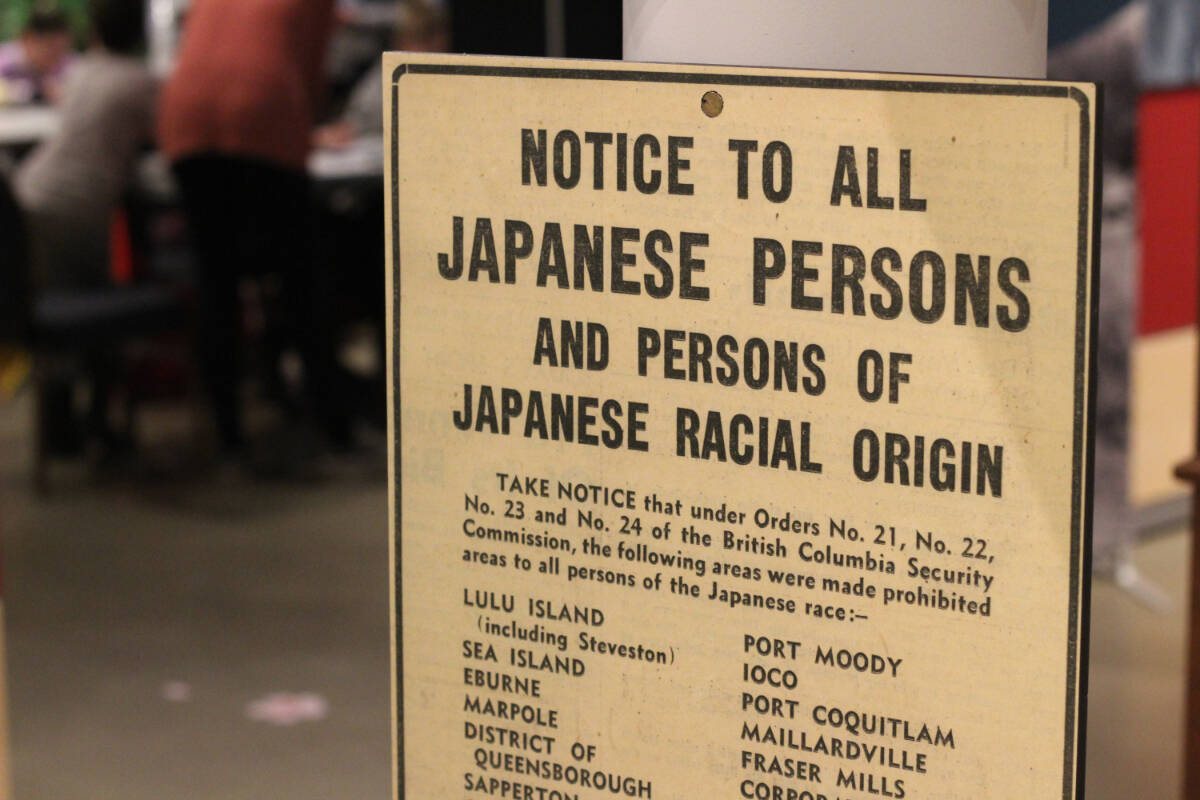More than 40 Japanese-Canadian families lived in the Brechin area of Nanaimo – that was until the War Measures Act was introduced in 1941. Homes were taken and families forced out.
Two new exhibits on display at the Nanaimo Museum showcase the contributions to B.C. made by Japanese-Canadians, and explore the tragedy and injustice of the 1940s internment camps, and the community’s efforts to heal.
The first, Broken Promises, is a temporary travelling exhibit from the Nikkei National Museum detailing the stories of Japanese-Canadians from coastal B.C. during the uprooting, dispossession and exile in the 1940s. This feature is on display until Sept. 2.
Museum curator Aimee Greenaway says that when they learned Broken Promises would be coming to Nanaimo, it became an opportunity to fill in an underrepresented part of Nanaimo’s history by working with 7 Potatoes Society, also know as the Central Vancouver Island Japanese Canadian Cultural Society.
“Typically when we bring in a travelling exhibit we try to include a local component that links whatever that story is, whether it’s a Canadian story or a B.C. story, to what’s going on in the community,” Greenaway says. “In this case we decided the story was not well reflected in the museum, so we (had to) get the Japanese-Canadian community into the permanent gallery right away.”
From Herring Capital to Seven Potatoes is a new permanent addition to the museum delving into three local families during the 1900s: the Uyeyamas, Shimozawas and Yoshidas.
‘Herring Capital’ is an early nickname for Nanaimo. Due to racist laws limiting species of fish Japanese-Canadians fishers were allowed to catch, Japanese-Canadians hunted the abundant herring. This led to a booming herring economy with Japanese-Canadian salteries dedicated to the herring and herring shipments travelling overseas to China and Japan.
Following Japan’s Second World War attack on Pearl Harbor, the governments of B.C. and Canada began detaining all Japanese-Canadian families on the suspicion that they may side with Canada’s enemy. Families were imprisoned in internment camps and their homes, boats, lands and belongings were confiscated then auctioned off.
Even after the seven years of internment ended, families weren’t allowed to return to the West Coast.
In 1988, Prime Minister Brian Mulroney delivered Canada’s first apology for the tragedy.
Brian Sugiyama, vice-president of 7 Potatoes Society, said family lines that were displaced are still returning to the Island as recently as two years ago.
“Many times, these were people born in Canada but who had to leave their towns and homes and various places on Vancouver Island,” Sugiyama said. “It took a concentrated population that was living in Vancouver and Vancouver Island and dispersed it all the way across Canada; some 23,000 people were relocated.”
The permanent exhibit is on a dedicated wall, with attached photos and text showcasing Japanese-Canadian history before, during and after the war.
There is a period-appropriate filled suitcase, similar to the type a Japanese-Canadian in the 1940s would have used to pack all their belongings before they had to leave with 24 hours’ notice. A sign on the exhibit asks guests “If you only had 24 hours to pack before you were forced to leave your home, what would you put in your suitcase?”
Greenaway said she hopes visitors connect with some of the stories and leave with a sense of the vibrancy of the Japanese-Canadian community in Nanaimo, the legacies of that community and the work they’re still doing today.
Sugiyama said he wants people to walk away from the exhibit with the understanding that Canadian society from back then isn’t as distant as we sometimes think.
“What happened to the Japanese community could happen to any ethnic group right now…” Sugiyama said. “We would like to see no group persecuted because of racial or cultural background and I think that’s the message.”
Plan your adventures throughout the West Coast at westcoasttraveller.com and follow us on Facebook and Instagram @thewestcoasttraveller. And for the top West Coast Travel stories of the week delivered right to your inbox, sign up for our weekly Armchair Traveller newsletter!















 Skookumchuk Prairie purchase aimed at preserving B.C. grasslands
Skookumchuk Prairie purchase aimed at preserving B.C. grasslands